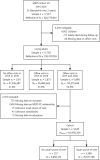Assessing the Longitudinal Impact of Physician-Patient Relationship on Functional Health
- PMID: 32928758
- PMCID: PMC7489969
- DOI: 10.1370/afm.2554
Assessing the Longitudinal Impact of Physician-Patient Relationship on Functional Health
Abstract
Purpose: Access to a usual source of care is associated with improved health outcomes, but research on how the physician-patient relationship affects a patient's health, particularly long-term, is limited. The aim of this study was to investigate the longitudinal effect of changes in the physician-patient relationship on functional health.
Methods: We conducted a prospective cohort study using the Medical Expenditure Panel Survey (MEPS, 2015-2016). The outcome was 1-year change in functional health (12-Item Short-Form Survey). The predictors were quality of physician-patient relationship, and changes in this relationship, operationalized with the MEPS Primary Care (MEPS-PC) Relationship subscale, a composite measure with preliminary evidence of reliability and validity. Confounders included age, sex, race/ethnicity, educational attainment, insurance status, US region, and multimorbidity. We conducted analyses with survey-weighted, covariate-adjusted, predicted marginal means, used to calculate Cohen effect estimates. We tested differences in trajectories with multiple pairwise comparisons with Tukey contrasts.
Results: Improved physician-patient relationships were associated with improved functional health, whereas worsened physician-patient relationships were associated with worsened functional health, with 1-year effect estimates ranging from 0.05 (95% CI, 0-0.10) to 0.08 (95% CI, 0.02-0.13) compared with -0.16 (95% CI, -0.35 to -0.03) to -0.33 (95% CI, -0.47 to -0.02), respectively.
Conclusion: The quality of the physician-patient relationship is positively associated with functional health. These findings could inform health care strategies and health policy aimed at improving patient-centered health outcomes.
Keywords: Medical Expenditure Panel Survey; United States; functional health; impact; primary care; relationship.
© 2020 Annals of Family Medicine, Inc.
Figures


References
-
- Macinko J, Starfield B, Shi L. Quantifying the health benefits of primary care physician supply in the United States. Int J Health Serv. 2007; 37(1): 111–126. - PubMed
Publication types
MeSH terms
LinkOut - more resources
Full Text Sources
Medical
